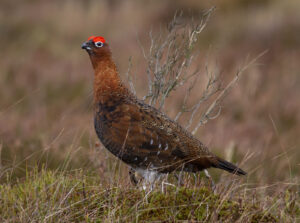Species
From rabbits to eagles and everything in between.


Birds
The Langholm Moor has always been a popular spot for birdwatchers, with many different species across the varied habitats.
Across the moorland habitats you can spot a range of different upland species, including hen harriers, curlew, black grouse, short eared owls, and you might even spot a visiting golden eagle!
In other areas of the reserve, in the woodland or along the river, you might see dippers and wagtails; pied flycatchers and redstarts; goshawks and cuckoos, and many, many more!
A local ecologist has compiled a list of all the species he’s seen on the reserve which can be seen here:

Mammals
The woodlands and forestry on the reserve provide a perfect, sheltered habitat for foxes and badgers. The clean water and fish populations in the Tarras make it a perfect habitat for otters, which you might be lucky to spot along the river, while water voles can be found in some of the extensive drainage ditches and burns across the moorland.

Reptiles, amphibians, and fish
In warm weather you might be able to spot slow worms, common lizards, grass snakes or even adders basking on rocks or the road.
In dark damp areas you could spot a toad, while the ditches and wetlands across the reserve provide the perfect habitats for frogs, smooth newts and palmate newts.
The river Esk is famously popular with fishermen, and as a tributary to the Esk, the Tarras is also home to salmon and trout.

Moths and other insects
The wide variety of plants and habitats on the reserve mean that it has high insect biodiversity. Moth trapping surveys has shown that there are around 170 different species on the reserve, including the first Dumfries and Galloway record for the Northern Drab moth.
You can see a full list of the moths species found on the reserve here:

Plants, mosses and bryophytes
A quick glance across the moorland will show an abundance of blaeberry, heather, cotton grass, bracken and other grasses, but take a closer look a you will see that there is more than meets the eye with a huge variety of different plants, including mosses, lingonberry, cranberry, and many others.
Take a walk through some of our woodlands to take in the impressive views of our ancient alder and veteran oak trees, as well as the extensive woodland regeneration that’s growing across different areas – proof that nature will regenerate naturally if given the chance!
You can read survey results for plants, mosses and bryophytes here: